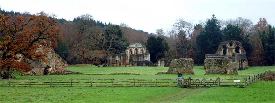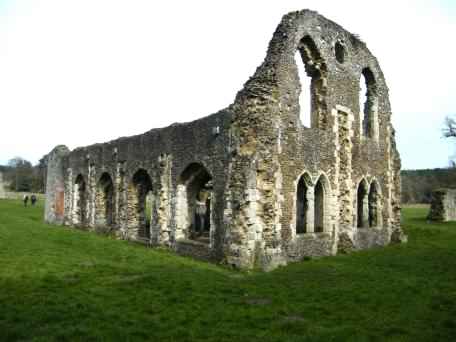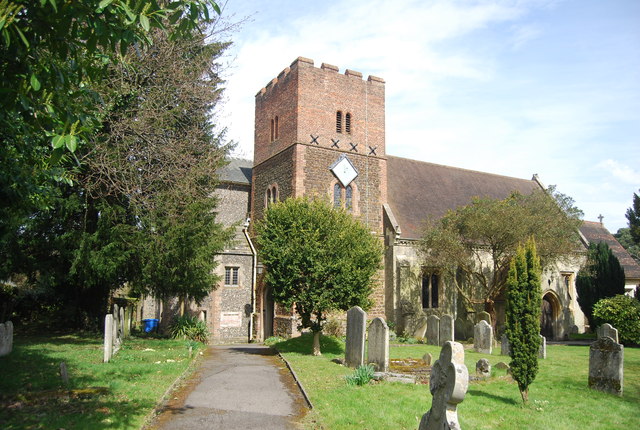<<< Prev
Waverley Abbey (2)
Next >>>
by Tim Childerhouse
Based on extracts from Baigents 1882 book
"On The Abbey Of The Blessed Mary Of Waverley"

Waverly Abbey ©thecyberfarm.com
©2016–
Just two and a half miles to the south of Aldershot are a few fragmentary remains of the buildings of Waverley Abbey[1] and its church, which barely enable us to realise that upon that spot there once stood a magnificent and grand place of worship of the Early English type, surpassing in its dimensions, several of our cathedrals. Although the Abbey lies across the county border, its monks farmed in Aldershot and brought prosperity to our, then, tiny village.
The Cistercians owed their first introduction into England to William Giffard[2][7] (the second Bishop of Winchester) who, after the Conquest was Chancellor to Henry I. It was Henry who, on the 24th November 1128, laid the foundations of the Abbey of Waverley for the reception of an Abbot and 12 monks. The members of this order soon became noted for their greatest excellence, the professions of agriculture, architecture and commerce. The 60 acres of this monastic order soon extended to 500 acres, encroaching as far as Wanborough, Tongham and Aldershot, where they established Granges or farms upon their outlying estates.

Church of St. Michael the Archangel
Aldershot. Picture courtesy
N. Chadwick licensed for reuse.
We have no record of when the monks first settled in Aldershot but the first documented evidence is contained in the 1287 schedule of the Crondall Rental – "ALRESSHATE (Aldershot). The Monks of Waverlye hold 31 acres of encroachment. These 31 acres lay to the south and were bounded by Church Lane, Church Lane East, Eggars Hill and terminating at the line of Boxalls Lane. The site of the Grange was a few hundred yards from the church of St. Michael the Archangel[3], and was manned by one monk and eight clerics, tending, perhaps, many hundreds of sheep.
In the same rental: "Adam Clericus[4] and Margaret of Overescumbe hold one virgate[5] of land containing 29 acres on payment, therefore, of 2/- on the Feast of St. Michael". This land extended from the western limit of the monks property to the Blackwater Stream, the county border, making at least 60 acres of sheep pasture. Of Margaret we have no knowledge but, at this time, Adam (Clericus) is listed as the first recorded Chaplain, perhaps he was on loan from Waverley, and he may have been in charge of the Grange, then managed by a monk and eight clerics.
After the dissolution in 1536 of the Abbey at Waverley, the White family of Aldershot, then living at The Lodge in Church Lane East, took over the 31 acres on payment of 4s 4d, an increase of one penny in 300 years, such was the rate of inflation in those years.
Wikipedia entry for Waverly Abbey, and at Historic England, and at English Heritage. [top]
Wikipedia entry for William Giffard, Lord Chancellor of England and the second Bishop of Winchester. [back] [top]
Wikipedia entry for the Church of St. Michael the Archangel, Aldershot, and at The Church of England. [back] [top]
Clericus – translates from Latin to several English terms – clergyman, cleric, clerk, priest, scholar, scribe or secretary. [back] [top]
Virgate – a variable measure of land, we have found several meanings for "Virgate" – (remember that Brickfields Country Park is 7.8 acres or 3.15 hectares). A virgate was also called the "Yardland" or "yard of land". [back] [top]
- 12 acres, an area deemed big enough to provide food for seven people. Or....
- A variable measure depending upon the quality of the land but was between 15 and 60 acres. Also....
- An old English unit equal to 1/4 hide[6]. This is roughly 30 acres or 12 hectares.
Hide – a very old English unit of land area, dating from perhaps the seventh century. The "Hide" was the amount of land that could be cultivated by a single plough and thus the amount of land necessary to support a family. Depending on local conditions, this could be as little as 60 acres or as much as 180 acres (24–72 hectares). The hide was more or less standardized as 120 acres (48.6 hectares) after the Norman conquest of 1066. The hide continued in use throughout medieval times, but it is now obsolete, also known as the "Carucate". [back] [top]
From "A short history of the old parish church of Saint Michael the Archangel" by J.W. Branson
It is not known when the St. Michael the Archangel was built but in a deed dated 24 October 1409, one John–atte–Halle (John at the Hall) is named as the donor of the land for the churchyard. The Hall may well have been on the site of the present "Aldershot Lodge" close by. The earliest written mention of Aldershot as a parish dates from the time of William Giffard, the second Bishop of Winchester, who in A.D.1121 caused an annual gift to be made at Pentecost, by each parish to the Cathedral for lights and other needs. There is a legal document dated Feb. 16, 1171, confirming that "Halreshet" (Aldershot) was contributing thereto. It was the same Bishop who invited a Prior and twelve monks to come from Burgundy to found Waverley Abbey in A.D.1128. They were Cistercians who did not undertake parochial work, however they rented 35 acres of land here for 4s. 3d. p.a. At the dissolution in 1536 it was taken over by Sir John White, who had to pay four shillings and fourpence a year for it! [back] [top]
Site design ©1999– Brickfields Country Park - Privacy -